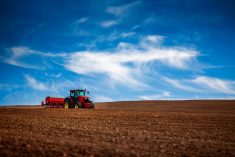Kirschenmann says&
If big farms can make it on volume and efficiency and small farms by supplying key local
markets, does the future of agriculture look like a big donut, with nothing in the middle?
If you had asked economist Fred Kirschenmann that question five years ago, he might
have answered yes. Now, he says, there s a growing body of evidence that mid-sized farmers
can carve out a third way.
The key is to integrate elements of both the large and the small model into something
Read Also

Riding the tariff roller-coaster
What producers are doing to minimize the risk created by ongoing trade uncertainty.
because you can t win that game, but work with partners to lower your costs and give yourself
enough heft to supply the traditional retail chains, albeit at a somewhat higher price point.
So why would a food consumer pay this higher price? Consumers are looking for a good story
with their food, Kirschenmann says. They want to feel a connection to the people who produce it.
It s not an overnight process, Kirschenmann says, but it can eventually pay dividends.
He points to Organic Valley (www.organicvalley. coop) which began with seven Wisconsin
dairy farms in 1998. Today there are 1,400 farms in the system and the co-op has annual
sales of $600 million.
Or there s Country Natural Beef (
www.oregoncountrybeef.com)which has about 30 ranchers
that are certified for humane animal husbandry practices and environmentally sensitive
land management practices and are notching up about $80 million a year in gross sales.
The key to making this third way work is to ensure you re not pricing yourself out of the
market, Kirschenmann says. There is a price ceiling, he says, but consumers do seem
to be willing to pay a reasonable premium.
Christoph Weder had to find a different way of doing business. The more he looked at the cattle industry, the less he saw any long-term hope for his mid-sized farm.
Across Canada, with cow-calf operators feeding into a system that typically ends up at Lethbridge feedlots, thousands of farmers have wrestled with those same fears over the past two decades, with the result that thousands of farmers have exited the industry.
Then Weder had his eureka moment. He didn t have to go it alone.
The beef producer from Alberta s Peace River country started rounding up like-minded ranchers from across the Prairie provinces to form Prairie Heritage Beef Producers, which markets old fashioned ranched beef, raised without growth hormones, antibiotics or animal byproducts.
Now, the group has 18 members across three provinces, and a solid track record of getting above-market prices for a growing volume of their branded cuts.
The individual farms have given up some autonomy. They ve had to commit to the group s positioning statement (Prairie Heritage Beef is a partnership of eco-committed ranch families that work together to sustainably produce and market beef, connecting the ranch gates to the consumer plates) making it not just a marketing statement, but an accurate description of how they farm every day.
They ve had to accept that who they are and how they farm are key to the overall group s success, as customers can see by checking out each of their profiles on www.prairieheritage.ca.
As well, group members have also needed to adapt their businesses to the partnership, much as farmers have to accept some curbs on their decision making when they enter any kind of partnership, even if it s a straightforward machinery-sharing partnership with a cousin down the road.
In return, though, these mid-sized farms have been able to secure their place in the beef industry.
The strategic decision to move in a new direction was a straightforward dollars-and-cents response to a clearcut business problem, Weder says.
There just isn t enough money in doing it the other way, Weder told COUNTRY GUIDE with a rueful chuckle. Do I need to be any more specific than that? If you look at return on investment, the cow-calf sector is the worst in all of agriculture.
Weder says the project hasn t been an easy one to get up and running, but today Prairie Heritage Beef Producers slaughters and markets about 5,000 animals a year, with markets as far away as Europe.
What keeps them going, says Weder, is a shared belief that a strong marketing effort and a focus on building a solid customer base can create the sustainable future that eluded the old model and its unstated assumption that if you produce it, someone will want to buy it.
I think it goes all the way back to our ag schools, says Weder, who graduated with a masters degree in range management from Oregon State. We learn all about production, production, production but we learn next to nothing about marketing. Maybe we should be learning a whole lot more about marketing.
That s meant there had to be a tough paradigm shift for farmers who had been raised in an industry built on the idea that commodities are interchangeable, and that one farm s beef is identical to any other farm s beef.
Yet examples of successfully differentiated products are all around us every day. Consider the humble can of cola, for example. Colas are all quite similar. They re coloured, flavoured sugar-water















